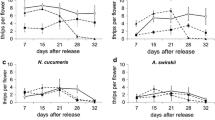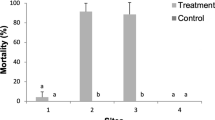Abstract
Effect of the nematicide carbofuran on the population development of the citrus parasitic nematodeTylenchulus semipenetrans and predacious soil mites in citrus orchard under organic manure regime of fertilization.
In an Egyptian citrus orchard under farmyard manure regime of fertilization an experiment was conducted for three successive seasons (1993–1995) to investigate the potency of the nematicide carbofuran against the population of the citrus parasitic nematodeTylenchulus semipenetrans Cobb. and any side-effects on predacious soil mites. An initial reduction inT. semipenetrans populations was observed after application, although a remarkable increase in the population occurred afterwards. In contrast, the average number of predators decreased, particularly in 1995. In organic plots without nematicide, predators increased to great numbers andT. semipenetrans caused negligible injury. In the fertilizer-free treatment, theT. semipenetrans population was low although that of predacious mites was high. The study indicated that carbofuran treatments reduced the population of predacious soil mites and in their absence the population of the parasitic nematode,T. semipenetrans was likely to increase.
Similar content being viewed by others
References
Bone, V. M., 1983: Peropal, Alsystin and Cropotex: Evaluation of their effect on beneficial arthropodes. Pflanzenschutz Nachrichten Bayer, 38–53.
Badra, T.;Saleh, M. A.;Oteifa, B. A., 1979: Nematicidal activity and composition of some organic fertilizers and amendments. Revue Nematol,2 (1), 29–36.
Childers, C. C.;Duncan, L. W.;Wheaton, T. A.;Timmer, L. W., 1987: Arthropod and nematode control with Aldicarb on Florida citrus. J. econ. Ent.90, 1064–1071.
Edwards, C. A.;Lofty, J. R., 1971: Nematicides and the Soil fauna. Proc. 6th insecticide, fungicide, Conf., I: 158–161.
Edwards, C. A.;Thompson, A. R., 1973: Pesticides and the soil fauna. Residue Rev., Ed,45, 1–79.
El-Banhwy, E. M.;Osman, H. A.;El-Sawaf, B. M.;Afia, S. I., 1997: Interactions of soil predacious mites and citrus nematodes (Parasites and Saprophytes), in citrus orchards under different regime of fertilizers. Effect on the population densities and citrus yield. Anz. Schäd. Pflanz. Umwelt.70, 20–23.
El-Banhawy, E. M.; El-Borolossy, M. A.; El-Sawaf, B. M.; Afia, S. I., 1997: Biological aspects and feeding behaviour of the soil predacious miteNenteria hypotrichus (Uropodina: Uropodidae). Acarologia38 (in press).
El-Makawi, H. I.; Zaki, M.; Deiab, M., 1986: Insecticidal pollution to Egyptian environment, part III: Soil contamination with insecticide: 295–314, National centre for social and criminal studies pub. (in Arabic), 346 pp.
Habeersaat, U., 1989: The importance of predatory soil mites as predators of agricultural pests, with special reference toHypoaspis angusta karg, 1965 (Acari: Gamasina). Doc. Thesis, Federal Inst. Technology, Zurich, Switzerland.
Imbriani, J. L.;Mankau, R., 1983: Studies onLasioseius scapulatus a mesostigmatid mite predacious on nematodes. J. Nemat.15, 523–528.
Inserre, R. N.;Davis, D. W., 1983:Hypoaspsis aculeifer mite predacious on root-knot and cyst nematodes. J. Nemat.15, 324–325.
Jenkins, W. R., 1964: A rapid centrifugal flotation technique for separating nematodes from soil. Plant dis. Dep.48, 692.
Karg, W., 1983: Verbreitung und Bedeutung von Raubmilben der cohors Gamasina als Antagonisten von Nematoden. Pedobiologai25, 419–432.
Konsouh, A. S.;Hafez, S. M., 1981: Influence of soil contamination with pesticidal sprays on the magnitude of mite fauna. Bull. soc. ent. Egypte, Econ. Ser., 1976/1977, pub/1981,10, 37–40.
Miline, D. L.;Willers, P., 1979: Yield and nutritional responses to phenamiphos treatments of citrus infested with citrus nematodes. Subtropica1, 11–14.
Morris, H. M., 1922: The insects and other invertebrate fauna of arable land at Rothamsted. Ann. appl. Biol.9, 282–305.
Oteifa, B. A.;Shafiee, V. A.;Eissa, F. M., 1965: Efficacy of DBCP flood irrigation in established citrus. Plant dis. Dep.49, 598–599.
Philis, J., 1969: Control of citrus nematode,Tylenchulus semipenetrans with DBCP in established cyprus citrus groves. Plant dis. Dep.53, 804–806.
Van De Bund, C. F., 1972: Some observations on the predatory action of mites on nematodes. zeszyty. probl. post. Nauk Roln129, 103–110.
Van Gundy, S. D., 1984: Nematodes. In: Integrated pest management for citrus. Univ. Calif. Riverside, 129–131.
Vilardebo, A.;Soalh, A.;Devaux, R., 1975: Utilisation du D B C P, du phenamiphos et du prophos contreTylenchulus semipenetrans dans les vergers du Maroc. Fruits30, 313–317.
Walter, D. E.;Kaplan, D. T.;Davis, E. L., 1993: Colonization of greenhouse nematode cultures by nematophagous mites and fungi. J. Nemat.25, 789–794.
Author information
Authors and Affiliations
Rights and permissions
About this article
Cite this article
El-Banhawy, E.M., El-Borolossy, M.A. & Afia, S.I. Effect of the nematicide carbofuran on the population development of the citrus parasitic nematodeTylenchulus semipenetrans and predacious soil mites in citrus orchard under organic manure regime of fertilization. Anz. Schadlingskde., Pflanzenschutz, Umweltschutz 71, 69–71 (1998). https://doi.org/10.1007/BF02767108
Issue Date:
DOI: https://doi.org/10.1007/BF02767108




